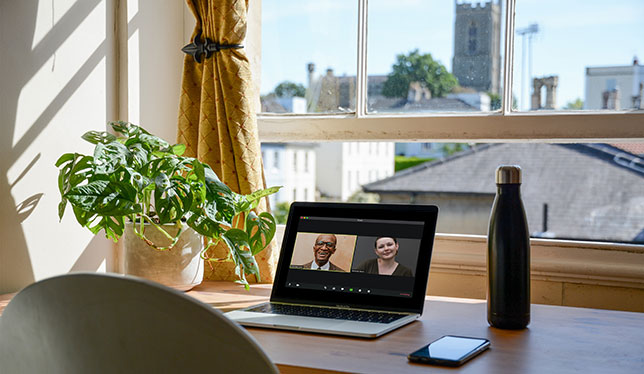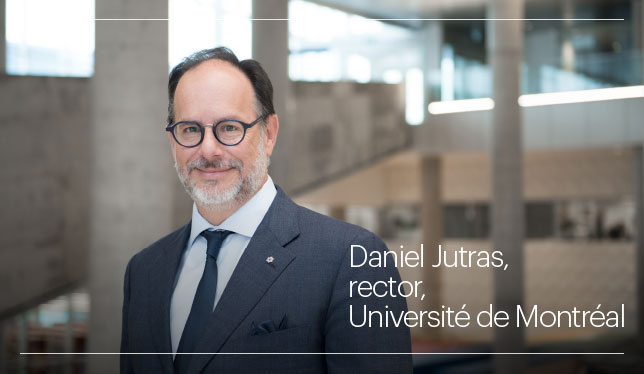
Compassion comes first
Daniel Jutras, rector, Université de Montréal
We all remember March 16, 2020 as the day when the governments of Canada and Quebec imposed restrictions to slow the spread of COVID-19. Daniel Jutras will also remember it as his first day as rector-designate of Université de Montréal.
In fact, the “designate” position had been created in response to a request from Dr. Jutras himself, who had been a professor in the faculty of law at McGill University until March 13. “To my knowledge, it was the first time U de M recruited someone from the outside,” says Dr. Jutras, noting that he benefited greatly from the generosity of his predecessor, Guy Breton, during the transition period that led up to his official entry into his new role on June 1.
Despite his many years working at a neighbouring Montreal institution, Dr. Jutras didn’t know many people at U de M. So his first challenge was to put together his administrative team. When he first submitted his application, he never could have imagined that he’d have to conduct virtual interviews in March and April to identify the team that would be supporting him. “There were vice-rectors I had asked to join my team whom I didn’t meet in person until mid-summer. It was a really risky gamble,” says the rector, adding that it has since paid off.
When his appointment was announced in February, he hoped he would be able to “motivate the troops to dream a little bigger.” But, as the pandemic hit, he was forced to acknowledge that this was “probably the hardest issue” he faced. While he refuses to accept that big dreams are impossible in a time of COVID-19, he can’t deny the fatigue that people are feeling. “People are really focused on their day-to-day lives, there are lots of things to manage, and it’s not easy,” acknowledges Dr. Jutras, whose goal was to be a compassionate leader and who is now working hard to make that goal a reality.
“The pandemic has really put universities at centre stage.”
Though he understands that it’s easy to focus on the negative at times like this, Dr. Jutras says he tries to see the good side of things. “One positive thing is that the pandemic has really put universities at centre stage. It’s obvious now – in the public discourse, in the media and in the broader conversation among the general public – that academic establishments occupy a very visible place and play an extremely important role, both in terms of science and more broadly in their contribution to the economic recovery.”
The importance of the academic mission is an important part of the enthusiasm he feels when he thinks about his responsibilities as rector. “It’s ironic, because people might imagine that my life is a nightmare right now, but it really isn’t. You have the sense of accomplishing things in your day-to-day work, which is always gratifying. It’s been a long time since I’ve had this much fun at work,” he says before moving on to another video call.
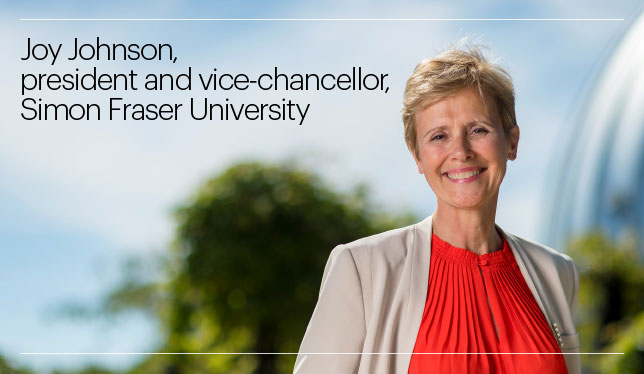
Priorities: personal and pandemic
Joy Johnson, president and vice-chancellor, Simon Fraser University
When Joy Johnson was installed as president of Simon Fraser University during convocation in mid-October, she was robed with a newly designed academic gown featuring motifs chosen by expert weavers from the Squamish Nation. Her wife and her mother were by her side as fog drifted in – a dramatic touch to the ceremony on the university’s outdoor Convocation Mall.
“The university is very quiet, and that’s hard. But it’s also symbolic of what everyone has given up.”
Instead of delivering her speech to hundreds of students, faculty and families, she spoke to a small gathering of university leaders and guests – and a video camera, capturing the event for later broadcast. Such is convocation in a COVID world. But when you’re a new president keen to connect with those you’re leading, it puts a fine point on the sacrifices being made to keep everyone safe during the pandemic
“This is convocation week,” Dr. Johnson says from her home, a day after the ceremony was broadcast. “I should be shaking every graduate’s hand. I should be on campus, really present.” Instead “the university is very quiet, and that’s hard. But it’s also symbolic of what everyone has given up.”
Nevertheless, she believes the circumstances created by the pandemic make this the right time to be taking on her new role. Dr. Johnson started her career as a nurse. She later became a gender and public health researcher before becoming SFU’s vice-president, research and international. These experiences have made her “very comfortable with recognizing that people are struggling and hearing what that’s about. I think that’s what the university needs right now.”
The pandemic has made it more challenging for her to fulfill some of her priorities – a Zoom call can be an awkward place to hold the difficult conversations necessary to move the dial on equity, diversity and inclusion, for example. An important ceremony as part of establishing a First Peoples’ Gathering House at SFU, related to her reconciliation priority, had limited participation because of safety protocols. Still, the pandemic has shown how important such work is: “It has shone a light on the inequities in the system.”
Nevertheless, Dr. Johnson has been able to move her agenda forward since her presidency officially began September 1. The EDI conversations are still happening. There are more mental health supports and bursaries for students. The university set up its HIVE program – a way for new students to connect live and virtually with those sharing similar courses and interests. “It’s about trying to be creative,” she says. It’s also about recognizing that her leadership priorities are a long game.
That includes recognizing that lockdown is not forever, life goes on, and that the university must plan for eventual reopening. Dr. Johnson dipped her own toe into those waters by working a couple of days a week on campus in the fall. Some local businesses such as the tech industry have experienced increased demand thanks to the pandemic so she’s been having conversations about what the university can do to support labour reskilling.
And there are lessons to carry forward into the post-pandemic university around alternative forms of learning and working. “My hope is that we wouldn’t return to the way things were,” Dr. Johnson says. “I’m looking forward to what that’s going to be like.”
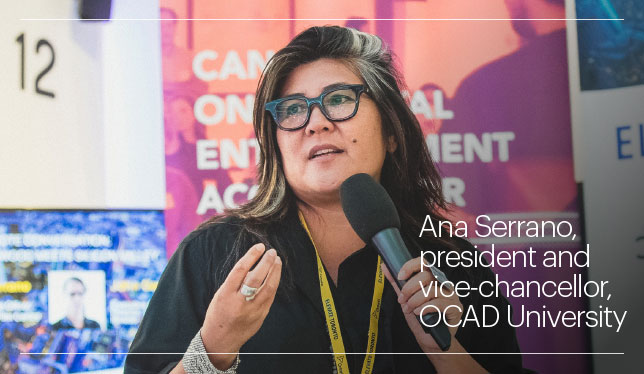
A melding of time and space
Ana Serrano, president and vice-chancellor, OCAD University
Ana Serrano says her first working day in early July as OCAD University’s new president and vice-chancellor was “a blur.” She does remember that it played out from her downtown Toronto dining-room table, which was still serving as her office by mid-fall. It was not what she had imagined when she was first announced as the new leader of the art, design and media university at the beginning of the year.
“The thesis that artists and designers play a tremendous role in helping society move forward came to light as we approached February and March.”
“In January, what I was very excited about was joining a community of creators,” she says. She was also keen to step into an institution that had positioned itself to take on many of society’s great challenges, from climate change to inequities of all kinds, using the power and insights of creative practice. The eventual pandemic and its social and economic fallout have only accelerated this work and confirmed the important part it has to play in Ontario’s pandemic recovery, she said.
“The thesis that artists and designers play a tremendous role in helping society move forward came to light as we approached February and March,” says Ms. Serrano. The university’s community exhibited work online that helped viewers make sense of an overwhelming situation. The university used its facilities to make personal protective equipment and its health design program mobilized to help people understand how to protect themselves. In the fall, OCAD U was a co-presenter at an online summit about revitalizing democracy called DemocracyXChange. “Learning how to negotiate between priorities – yours and others – is going to be a critical skill,” she explained. “Democratic practice is a creative practice.”
A more immediate task last summer was how to deliver programs, many in tactile media, to students from a distance. Faculty “took on the challenge,” says Ms. Serrano. “They really tried to capture the essence of what they were trying to teach in a new way.” Instead of trying to recreate the idealized artist’s studio – spacious and well-stocked with materials – faculty turned lockdown’s restrictions into a teachable moment.
“Studio is where you are. Studio is the space in which you stand,” she says. “How can you look in your kitchen and see the materials at hand as materials with which you can express yourself? How do you work with such constraints?”
Her background as the Canadian Film Centre’s former chief digital officer and founder of its Media Lab, a digital media incubator, has helped her roll with the changes. Working in the start-up culture and creating partnerships, such as CFC Media Lab and OCAD U’s Digital Futures program, has shown her “how to be super nimble, flexible, adaptable and positive.”
Establishing “presence” as a new leader in a virtual university has called on those skills. She participated in more than 800 hours of online meetings in her first 100 days, meeting more than 500 members of the university by name. Since then, she’s sent out biweekly communiqués addressed to faculty and staff, trying to be as honest and frank as possible about what’s going on, what’s keeping her up at night and what the university has accomplished. It’s not the same as being physically before them, but it brings her into her community’s day in another way.
“Time to me has become space.”
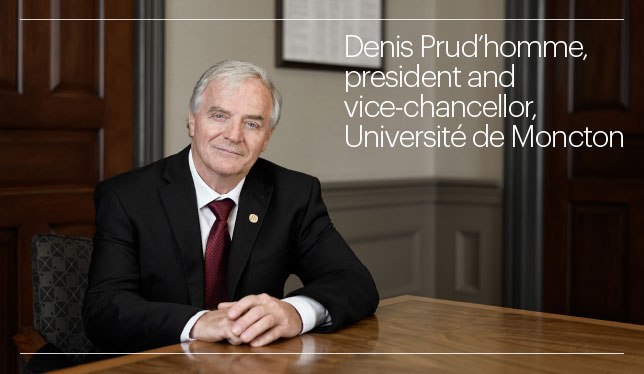
A clinician’s perspective
Denis Prud’homme, president and vice-chancellor, Université de Moncton
Denis Prud’homme first saw the pandemic from his perspective as interim CEO of the Institut du Savoir Montfort and academic vice-president of the Hôpital Montfort, in Ottawa, but that didn’t prevent him from understanding the challenges that awaited him starting July 1 as head of Université de Moncton.
He says he had the “advantage” of being able to take part in a “series of meetings to get up to speed on various issues” with his predecessor before officially starting in his new role. “That helped me a lot.”
“It’s often said that universities are like big ships that can’t change course quickly. In the context of the pandemic, if we look at the example of Université de Moncton, they were able to transfer the majority of courses online within about 10 days.”
As a clinician, Dr. Prud’homme is well aware of the anxiety caused by the pandemic, and he doesn’t hide his concerns about social isolation – especially since, at the time of this interview, he was worried about an increase in stress with the approach of mid-term exams. But, despite it all, he manages to see some positive aspects when he considers the creativity and solidarity that people have shown during this period. For example, he cites their impressive ability to adapt: “It’s often said that universities are like big ships that can’t change course quickly. In the context of the pandemic, if we look at the example of Université de Moncton, they were able to transfer the majority of courses online within about 10 days. The professors adapted quickly.”
Dr. Prud’homme thinks about the start of his term, he identifies one important change: human contact. “When you come in as a new president, you want to establish that human contact before you talk about anything else, you want to talk in a context where you’re not making any decisions,” he says, explaining that this approach applies both to his interactions with the university community and to the role he plays at the community, political and public levels.
He regrets the fact that these initial contacts will have to be mostly virtual for the moment. Although he has met with professors and administrative teams since his arrival, he feels there’s a certain distance that comes with wearing masks.
While he couldn’t have predicted that he would be called on to manage the repercussions of a pandemic when he became university president, Dr. Prud’homme says he knew that he would probably have to weather a “storm” during his term. “There are all sorts of storms in academia,” he explains, and he believes that his role is to draw on his experience and leadership skills to keep the university running smoothly under challenging circumstances.
Because Université de Moncton is located in the heart of the Atlantic Bubble, the new president has naturally had to submit to the requirements of self-isolation for a period of 14 days. And he says he has taken this measure very seriously, explaining with a laugh that because of various recent trips, he has actually had to self-isolate four times in the past few months. He freely acknowledges that he is now more hesitant about leaving the Maritimes.
To those who are preparing to start a term as a university president, Dr. Prud’homme recommends “not being afraid to talk to their fellow presidents and get their opinions. My colleagues at other institutions offered me their help and a sympathetic ear when I needed their opinions, and that’s very valuable for a new president.”
